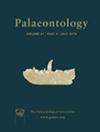封闭轮廓分析在物种分化和全型划分中的潜力:以下诺里亚(上三叠统)牙形刺为例
IF 2.3
2区 地球科学
Q1 PALEONTOLOGY
引用次数: 1
摘要
几何形态计量学方法在生物学和古生物学领域的应用越来越广泛。分类学就是一个很好的例子,科学家们长期以来的一个意图是尽可能地消除主观性。对于具有重要生物地层学意义的牙形石元素,这种方法的应用并不广泛。只有少数研究试图从这方面来处理牙形石元素的形态差异。本文根据P1元素和龙骨轮廓的标志和傅里叶分析,详细描述了下诺里亚(上三叠统)5个分类群(Ancyrogondolella quadrata、A. rigoi、A. triangularis、A. uniformis和Metapolygnathus mazzai)。两种方法在分类分化和暴露形状变异性方面的结果相似。共识形状的产生是为了客观地揭示每个分类单元的典型轮廓形状,使它们能够相互比较,并与各自样本群体的成员进行比较。结果表明,一个分类单元的全型通常不是一个平均的代表,而是一个具有很好分离形态特征的外围形态。方柱弓形虫和梨形弓形虫被证明代表了一个形态连续体,在这两个末端成员之间有充足的过渡形式,这可能会导致它们在生物地层学适用性上的偏差,然而它们的组合形状差异似乎太大了,无法将它们统一为一个物种。考虑到仅凭定性观察可能难以实现的结果,未来的分类学研究和类型材料指定可以从类似方法的应用中受益匪浅。本文章由计算机程序翻译,如有差异,请以英文原文为准。
Potential of closed contour analysis for species differentiation and holotype designation: a case study on lower Norian (Upper Triassic) conodonts
Geometric morphometric approaches become increasingly applied in the fields of biology and palaeontology. Taxonomy is a good example, where a long‐standing intention of scientists is to eliminate subjectivity as much as possible. In the case of biostratigraphically important conodont elements, the application of such methods is not widespread. Only a handful of studies attempted to deal with the morphological variance of conodont elements from this aspect. The detailed description of five lower Norian (Upper Triassic) taxa (Ancyrogondolella quadrata, A. rigoi, A. triangularis, A. uniformis and Metapolygnathus mazzai) is presented here based on landmarks and Fourier analysis of the P1 element and keel outlines. Both methods led to similar outcomes regarding taxonomic differentiation and exposing shape variability. Consensus shapes were generated to objectively reveal the typical contour shape of each taxon, which allowed their comparison with each other, and with the members of their respective sample population including the holotypes. The results demonstrated that the holotype of a taxon is generally not an average representative, but rather a peripheral form with well separable morphological characteristics. Ancyrogondolella quadrata and A. rigoi turned out to represent a morphological continuum with ample transitional forms between these two end‐members that may cause bias in their biostratigraphic applicability, however their combined shape variance seems to be too large for uniting them into a single species. Given the results that may be too subtle to realize based solely on qualitative observations, future taxonomic studies and type material designation could greatly benefit from the application of similar methodologies.
求助全文
通过发布文献求助,成功后即可免费获取论文全文。
去求助
来源期刊

Palaeontology
地学-古生物学
CiteScore
5.60
自引率
3.80%
发文量
43
审稿时长
6 months
期刊介绍:
Palaeontology publishes a wide variety of papers on palaeontological topics covering:
palaeozoology
palaeobotany
systematic studies
palaeoecology
micropalaeontology
palaeobiogeography
functional morphology
stratigraphy
taxonomy
taphonomy
palaeoenvironmental reconstruction
palaeoclimate analysis and biomineralization studies.
 求助内容:
求助内容: 应助结果提醒方式:
应助结果提醒方式:


